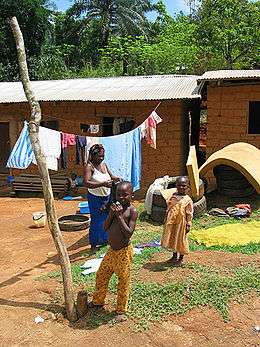Tikar people

The Tikar is a blanket term used for several ethnic groups in Cameroon. It has been used widely for different peoples and their culture.
There is a single ethnic group called the Tikar who live in on the Tikar Plain in Adamawa Region. They speak a Bantoid language called Tikar. Their population is approximately 25,000. The Bedzan pygmies (who also live on the Tikar Plain) share their language. The main Tikar towns are Bankim, Ngambe Tikar, and Magba.
The Tikar have elements of matrilineal and patrilineal descent. Their folk belief states that during pregnancy the blood that the woman would normally release during menstruation forms parts of the fetus. This blood is said to form the skin, blood, flesh and most of the organs. The bones, brain, heart and teeth are believed to be formed from the father's sperm.[1] In the case of a son, the masculinity also comes from this. The Tikar are also noted as mask-makers.
Quite different from these Tikar are many groups in the northwestern part of the country, in the Northwest Region near the Nigerian border whose royal families trace links to the Tikar royal family. Examples are the Nso' and the Wimbum from the North West as well as the Bamoun (from West Region) whose languages are different from Tikar. Although it is common to see statements such as the "Nso' are Tikar" or the Wimbum came from Tikari, that really should not be taken to be a statement about the culture, languages etc. of most of the people of that ethnicity.
On the 2006 PBS television program African American Lives, the musician Quincy Jones had his DNA tested; the test showed him to be of Tikar descent. In the PBS television program Finding Your Roots, former Secretary of State Condoleezza Rice learned she shared maternal heritage with the Tikar.
References
- ↑ "descent/graphics - Page 1". Lucy.ukc.ac.uk. Retrieved 2012-05-15.
- Fowler, Ian, and David Zeitlyn. (1996). "Introductory Essay: the Grassfields and the Tikar". In African Crossroads: intersections of history and anthropology in Cameroon. I. Fowler and D. Zeitlyn, eds. pp. 1–16. Oxford: Berghahn.
- Jeffreys, M.D.W. "Who are the Tikar?". (1964). African Studies 23 no. 3/4: pp. 141–153.
- Price, David. "Who are the Tikar now?". (1979). Paideuma 25: pp. 89–98.
- Zeitlyn, David. (1996). "Eldridge Mohammadou on Tikar Origins". Journal of the Anthropological Society of Oxford (JASO) 26 no. 1: pp. 99–104.
External links
- Tikar entry at Ethnologue site
- Article about Bamenda and Tikar